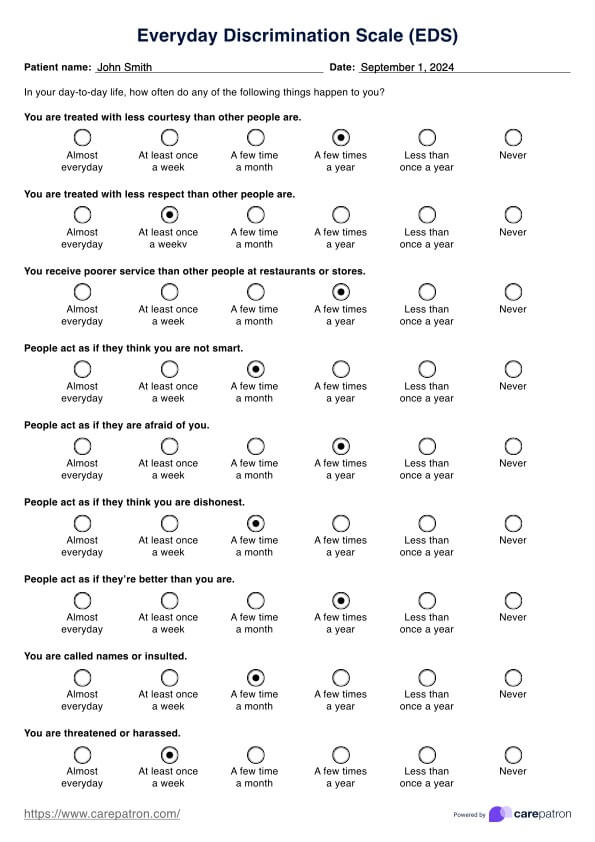Everyday Discrimination Scale (EDS)
Learn about the Everyday Discrimination Scale (EDS) and see an example. Download Carepatron's free PDF to use this tool for measuring perceived everyday discrimination.


What is the Everyday Discrimination Scale (EDS)?
The Everyday Discrimination Scale (EDS) is a widely recognized self-reported health tool designed to assess perceived discrimination in various daily contexts. This self-report measure evaluates how individuals experience and perceive unfair treatment due to their racial/ethnic background, gender discrimination, sexual orientation, or socioeconomic status. This tool helps identify the impact of on individuals seeking higher education or navigating other life domains.
While the EDS was developed as a social science instrument to capture nuanced experiences of discrimination, the EDS offers insights into how these experiences can impact both physical and mental health. Since the EDS focuses on perceived discrimination, it reflects how individuals interpret and react to everyday instances of unfair treatment. This measure is crucial in health psychology and behavioral medicine as it helps uncover the links between discrimination and health. By assessing perceived racial discrimination and other forms of bias, the EDS provides valuable data on mental health correlates of discrimination.
The EDS has been used in health-related studies like the National Survey of American Life to explore the relationship between discrimination and health outcomes. It sheds light on how discrimination experiences are related to poorer service, mental health issues, and physical health concerns.
Everyday Discrimination Scale (EDS) Template
Everyday Discrimination Scale (EDS) Example
How to use our Everyday Discrimination Scale template
Implementing the Everyday Discrimination Scale effectively can provide valuable insights into how discrimination affects your patients' health. Here’s a straightforward guide on how to use Carepatron’s Everyday Discrimination Scale template in your practice.
Step 1: Access and download the scale template
Click "Use template" to open the customizable Everyday Discrimination Scale template on the Carepatron app. You can also save a non-customizable but fillable version by clicking "Download."
Step 2: Review the scale
Before administering the EDS, thoroughly review the scale to familiarize yourself with its structure and questions. This step ensures you understand the nuances of the questions and can interpret responses accurately. It also helps in preparing for any potential questions or clarifications your patients might have.
Step 3: Introduce and use the scale to the patient
Introduce the Everyday Discrimination Scale to your patient by explaining its purpose and how it relates to their overall well-being. Provide clear instructions on how to complete the scale and ensure they understand that their responses will help in assessing their experiences of discrimination and its impact on their health.
Step 4: Discuss results with the patient
Once the patient has completed the EDS, discuss the results with them in a supportive and empathetic manner. Review their responses and explore any patterns of perceived discrimination they have reported.
Scoring
The Everyday Discrimination Scale is scored by first recoding responses to questions 1 through 10. For each question, recode answers of "a few times a year" or more frequently (responses 2-5) as 1, and answers of "less than once a year" or "never" as 0. Then, sum these recorded responses to obtain the summary score. If the total score is 1 or higher, follow-up questions should be asked to gain a deeper understanding of the reported experiences. This scoring approach helps identify individuals who may be experiencing frequent discrimination and require further assessment.
Next steps after using the EDS
After administering the Everyday Discrimination Scale (EDS), the next steps involve analyzing and interpreting the results to address any issues of racial discrimination or health disparities. Begin by reviewing the summary score and any follow-up responses to assess the extent of perceived discrimination experienced by the patient.
Consider how these findings might reflect broader trends in population health research, particularly regarding racial differences and their impact on mental health outcomes. Investigate any correlations between the reported discrimination and the patient’s physical appearance, socioeconomic status, or ethnic groups to understand the full scope of their experiences.
Commonly asked questions
The Everyday Discrimination Scale is designed to measure the frequency and impact of discriminatory experiences in everyday life. It helps identify how discrimination affects individuals' mental and physical health by assessing their encounters with unfair treatment in various settings.
The Everyday Discrimination Scale is known for its high reliability, demonstrating consistent results across different populations and settings. This reliability is supported by its strong internal consistency and test-retest stability.
The Discrimination in Medical Settings Scale evaluates experiences of bias and treated unfairly encountered in public health care environments. It focuses on how discrimination affects individuals' access to and quality of medical care.
The Daily Life Experiences Subscale measures the frequency of everyday discriminatory incidents that individuals encounter in various aspects of their daily lives. It captures the subjective experience of discrimination and its impact on daily functioning and well-being.




















-template.jpg)



















































































